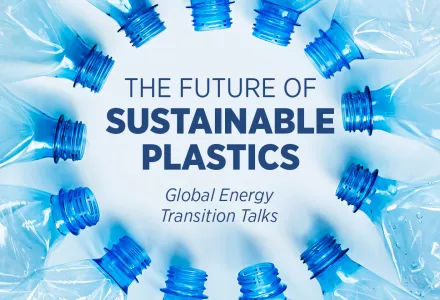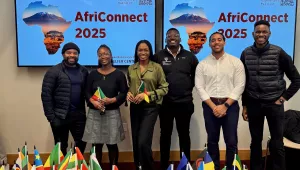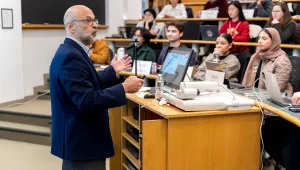Plastic Today
By Phoebe Fallon
The webinar began with a presentation of Dr. Nicola De Blasio and Phoebe Fallon’s report, Avoiding a Plastic Pandemic: The Future of Sustainability in a Post COVID-19 World. The report, published in January 2021, details the accumulation of plastic waste in the environment, the impact of COVID-19 on plastic use and disposal and recommendations for implementing a circular economy approach to the plastic value chain.
Since the inception of the plastic industry, more than 6.3 billion tons of plastic waste have been produced worldwide, the vast majority of which ends up in landfills. Plastic remains in the environment for hundreds of years, and even when degraded does not leave an ecosystem, but instead remains present as smaller pieces or particles. The structure of the plastic value chain is linear, which is one of the causes of the plastic waste crisis. The linear economy approach—also known as a take, make, waste value chain—is one in which raw materials are transformed into products that are then used until being thrown away as waste. This model creates value by manufacturing and selling as many products as possible at the cheapest cost possible and assumes that the planet’s resources are infinite. As a result, it does not take into consideration any end-of-life issues.
To curb the amount of plastic discarded as waste every year, a new approach is needed. Achieving a long-term sustainable future for plastic will require integration along the entire value chain; from design to reuse, together with a transition to a circular economy. A circular economy is characterized by a value chain approach in which a product’s end of life is taken into consideration from the moment it is developed, and resources are reused instead of being continuously added. In order to improve the plastic value chain and eventually transition into a circular economy for plastics, existing recycling processes need to be streamlined and improved.
Today’s plastic economy is highly fragmented. To begin with, not all plastics are equal as they have different chemical and physical properties and lifespans. Furthermore, some are products by themselves (like water bottles) while others are parts of more complex products. For this reason, post-consumer plastic waste is usually very inhomogeneous and comprises a wide range of material, shape, color and size types requiring separation—a costly, time and energy-intensive process which often leads to lower quality materials. These differences are exacerbated by the lack of global standards and coordination across the value chain, which has allowed for the proliferation of different materials, labeling collection schemes, and sorting and reprocessing systems, all of which hinder overall sustainability. Furthermore, innovation activities are also segmented. The design of new materials is often disconnected from the development and deployment of after-use processes and infrastructure.
From an economic point of view, recycling is dictated by market demand, price, and regulatory considerations, and involves all stakeholders along the value chain. Consumers play a critical role since the way plastic products are used and disposed of has a significant impact on their quality and value post-use. Due to the fragmented state of the plastic economy, the only widely adopted technology for the large-scale treatment of plastic solid waste today is mechanical recycling, also called chop-and-wash. In this process, plastics are sorted by material type, ground, washed, and then dried to produce recycled flakes.
Due to the high temperatures used, progressive material deterioration becomes an issue. In general, the higher the temperature a polymer can withstand without losing its properties, the higher the quality it will have as a recycled material, but due to progressive deterioration plastics cannot be recycled infinitely. To mitigate this effect, the resulting plastic flakes are then usually blended with virgin plastic of the same type to produce materials with suitable properties for manufacturing. Recycling is dictated by market demand, price, and regulatory considerations, and these factors have prevented the wide-scale adoption of an alternative approach to chop-and-wash, which is chemical recycling.
Chemical recycling is a process encompassing various technologies and processes such as pyrolysis with a high tolerance to mixed and contaminated plastic waste streams. The goal of chemical recycling is to break the long polymer chains down into their original building blocks, or monomers, which can then be used as feedstocks for new plastics, fuels, waxes, or other valuable products. It yields materials of higher quality than those obtainable through simple mechanical recycling. However, this approach requires complex industrial processing equipment, and hence overall economics tend to be less favorable compared to the production of virgin plastic. As a result, this route is not yet deployed at an industrial scale globally. Both mechanical and chemical and recycling have drawbacks, and in some instances are not cost-effective when compared to the production of virgin plastic.
Incineration is sometimes also considered a recycling option since proponents claim that it allows for energy recovery in the form of heat. While the process might be convenient for the treatment of mixed waste because it avoids the need for sorting, it does not allow for recovery and reuse. Furthermore, since carbon is a major building block of plastic, simple incineration is a source of greenhouse gas emissions and potentially other hazardous substances. Incineration is therefore an example of a linear economy approach and not a recycling option for a sustainable plastic economy.
Thus far, the strategy to address the challenges associated with plastic production and use has been mainly based on the “three Rs” approach: Reduce, reuse, and recycle. And although any measure to curb the environmental impacts of plastic is a step in the right direction, a systematic change is needed. With this in mind, our recommendations for the plastic value chain are as follows.
- Increase the recyclability of plastics. This can be done by redesigning products to be easily recycled and reused. For example, instead of combining many types of plastic in one product which makes recycling more difficult and expensive, redesign productions so that manufactured goods are made of only one type of plastic. A classic example of this is a water bottle—instead of three types of plastic (bottle, cap, and label), it could be designed with one. Limit the number of specialized plastics and additives and introduce extended producer responsibility to create incentives for plastic products to be easily recyclable.
- Enhance existing recycling systems. Improve and harmonize existing collection and recycling systems and instate a better infrastructure to accommodate the proliferation of bioplastics. This can be done, for example, by increasing access to industrial composting plants. Mandate recycling targets and percentages of recycled materials and new products.
- Decarbonize plastic production. Switch to low carbon energy sources such as renewable energy or green hydrogen while substituting petroleum-based plastics with more sustainable materials such as bioplastics. In addition, continue to conduct life cycle analyses on new products to ensure their overall sustainability.
- Develop new public-private partnerships. Foster government support for research and development, either through investment mechanisms or private public partnerships. Align incentives, for example, by requiring producers to address the negative externalities of plastic waste, such as ocean cleanup. On a larger scale, develop global partnerships that combine technical and regulatory factors to harmonize value chains.
- Demystify the plastic sector for consumers. Ensure that local communities and the public at large have an appropriate appreciation for the critical role they play. Educate consumers on plastic life cycles and incentivize sustainable practices as the way that plastic products are used and disposed of has a significant impact on their value and quality post use.
To date, technological factors, economic considerations, but also consumers behavior have hindered the sustainable use of plastic and created a global environmental crisis. New geopolitical forces—such as the challenges of development and climate change—are reshaping the playing field and stakeholders around the world will need to decide their role in this transition. The transition to a sustainable future for plastic must encompass every aspect of the value chain; from production, to consumption, to disposal, and be based on a circular economy approach to ensure meaningful and overall positive effects.



